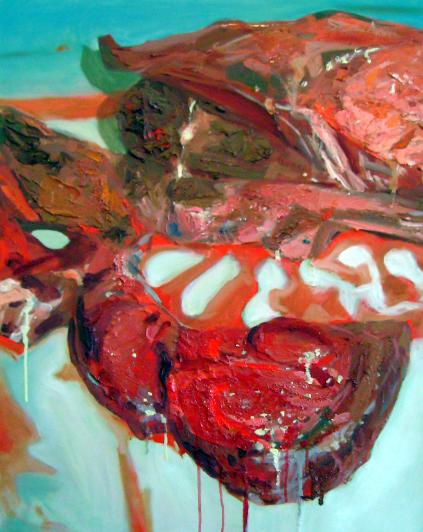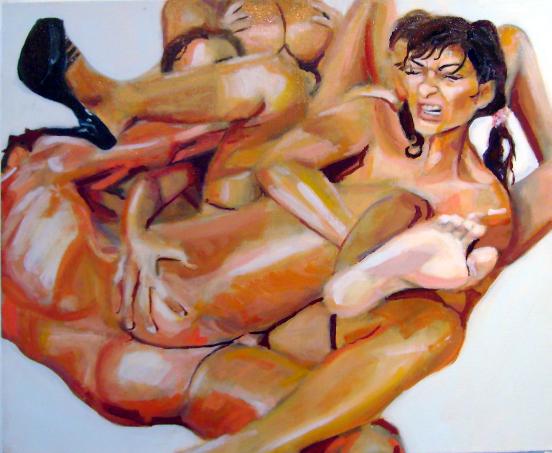speaks of the anonymity of death -- the stilling of the tremors of spirit and individual
identity. And on a crunchier note, it’s food. In the ongoing, bloody miracle of dietary
transubstantiation, flesh is re-converted to flesh and the death encountered most often
is just something in a sandwich.
Painting, like cooking, is also all about the often violent relationship of flesh to spirit,
taking meat puppetry in new directions. It uses a few dollops of colorful matter to close
the gap between desire and the reality principle, between faith and calculation. A work
of art is a way for the mind to overcome obstacles like time, distance and incapacity,
manifesting will and emotional response. Paintings especially try to do that in a
stridently metaphorical way, via a kind of aesthetic homeopathy. They invent a system
of equivalences, to address the incurable differences between what we want and what
we get.
Lately, fourth year CIA student Katy Richards has been making pictures of meat,
among other things. In her show “Primal Cuts” at Arts Collinwood she goes on to
establish personal and global contexts as well, for her exquisitely painted studies of
marbled chops and dripping gizzards. The gallery installation starts off with a group of
forty-five 6 inch square mini-panels -- pinkish, blood-like stains on delicate, intimate
pieces of stretched cloth, arranged in a grid. The flow of meat paintings then continues
around the room, interrupted by two small depictions of human bodies, orgiastically
intertwined. One woman’s face is visible in the tumult of “The Winner”; she grimaces
dramatically, as if to say, “Get me out of here!” Meanwhile, across the gallery, two little
paintings draw back from the melee of up-close encounters with texture and desire.
One shows Inuit hunters along an icy strand, slaughtering a walrus. The other, titled
“The Small Blue Life in it” , features a traditional hunter in a Robert Rauschenberg-like
mix of brushy landscape and print collage elements. Against icy blue passages we see
a chart and headlines about global warming.
But most of Richard’s paintings comment on, or conjure, the contradictory experiences
of flesh, living or dead, intimate, inflamed with passion, leaking long, juicy passages. If
all paintings build their worlds, or sections of worlds, from dead matter, that’s part of
what makes Richards’ forthright compositions satisfying: they don’t shilly-shally. Her
fluent visual descriptions of raw flesh are sufficiently vivid to enlist other senses,
summoning the smell and texture of a roast or steak, gripped in a living hand. Such
impressions can’t be divorced from the cruelty and pain they also evoke, and much sad
knowledge of self and of life. We are what we eat, must we eat what we are? And how
sudden are the transitions from desire to satisfaction, from pleasure to pain and back
again, from life to death? Richards depicts a roller-coaster ride of shifting perspectives
and sensations. She says this series began its evolution when she dated a hunter and
watched him stripping the animals he killed. Why not focus on just the meat, she said to
herself.
Why not, indeed? The paintings at “Primal Cuts” are very much about the history and
conventions of traditional painting. The term “still life” is a somewhat elliptical way of
saying “dead things,” of course, and during the past half millennium of Western art,
subjects like Richard’s “Prime Cuts” (2010), a painting showing two steaks or chops or
roasts connected across a white surface by a diagonal rivulet of red paint, have been
commonplace. In the past century Chaim Soutine, Francis Bacon, Lucian Freud, as well
as influential contemporary British artist Jenny Saville, have rendered flesh (and
sometimes meat) with a mixture of warm and cool, analytical and frenzied vigor, similar
to the energies that Richards brings to her compositions. Her lush, mostly in-your-face
arrangements (the out of focus seeming “Catfish and Apples” presents its subjects as if
placed a couple of inches from the painter’s nose) are dynamic and fresh, with an
abstract strength that binds the eye into the painter’s narrow space.
-- Douglas Max Utter
Primal Cuts: Katy Richards July 16—August 3, 2010
Arts Collinwood
397 East 156th Street, Cleveland, OH
216.692.9500


Naked Lunch
Katy Richards at
Arts Collinwood
Katy Richards at
Arts Collinwood